When looking for EPA-registered disinfectants safe for silk, choose products labeled as gentle or suitable for delicate fabrics. Look for labels indicating they are safe for silk and contain mild ingredients like quaternary ammonium compounds or hydrogen peroxide. Avoid harsh chemicals like bleach and high alcohol content. Always check the EPA registration number on the label to guarantee safety and effectiveness. If you want to learn how to disinfect your silk properly, keep exploring for detailed guidance.
Key Takeaways
- Verify the disinfectant is EPA-registered by checking for an EPA registration number on the label.
- Select products labeled safe for delicate fabrics or specifically for silk and other fragile textiles.
- Look for disinfectants with low alcohol content, neutral pH, or ingredients like quaternary ammonium compounds or hydrogen peroxide.
- Avoid disinfectants containing bleach, ammonia, or strong solvents that can damage silk fibers.
- Follow manufacturer instructions for dilution, contact time, and safe application to ensure fabric safety.
Understanding EPA Registration and Its Importance for Silk Care
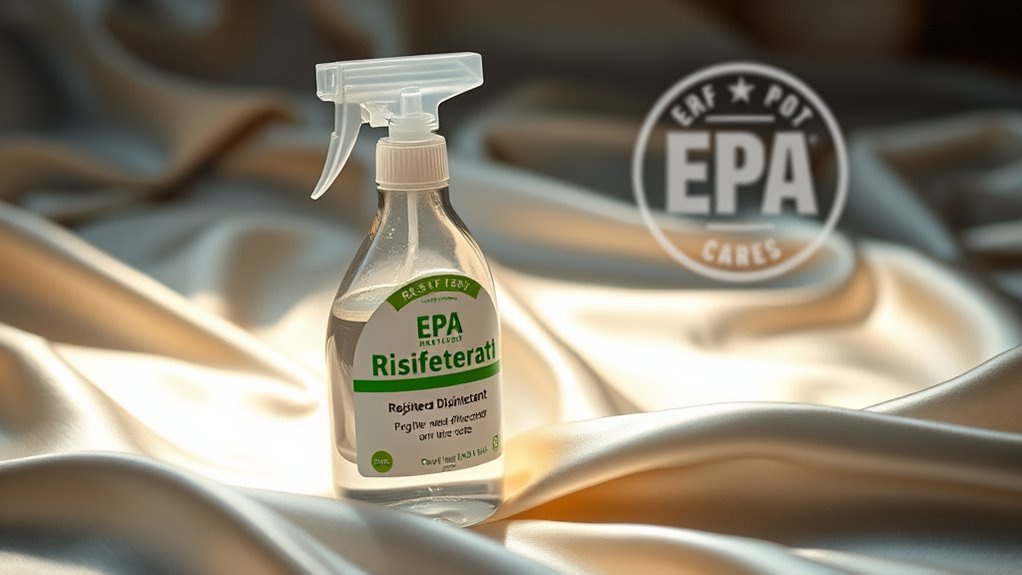
Understanding EPA registration is essential when choosing disinfectants for silk because it guarantees the product has been evaluated for safety and effectiveness. The EPA, or Environmental Protection Agency, reviews disinfectants to ensure they won’t damage delicate fabrics like silk. When a disinfectant is EPA-registered, it means it has undergone rigorous testing and meets strict standards for safety, toxicity, and performance. This helps you avoid products that could harm or stain your silk items. Using EPA-registered disinfectants provides peace of mind, knowing you’re selecting solutions proven to be effective without risking damage to your precious fabrics. Always check for the EPA registration number on product labels before use. It’s a simple step that ensures safe, reliable cleaning for your silk items. Additionally, verifying the disinfectant’s shelf life can prevent using expired products that may lose their efficacy or become hazardous.
Characteristics of Disinfectants Suitable for Use on Silk
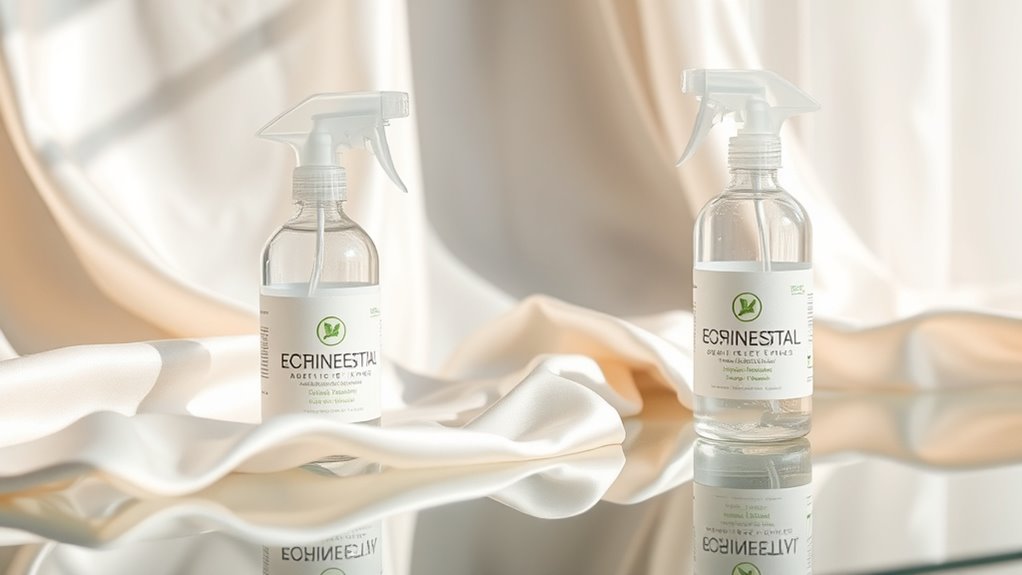
When selecting disinfectants for silk, it’s important to look for products that are gentle yet effective. You want a disinfectant that kills germs without damaging the delicate fibers. Look for formulations with low alcohol content or those specifically labeled as safe for delicate fabrics. The pH level should be neutral or slightly acidic, preventing harsh reactions that weaken silk. Avoid disinfectants containing bleach, ammonia, or strong solvents, as they can cause discoloration or fiber deterioration. A good disinfectant for silk should also be quick-drying and residue-free, ensuring no sticky or stiff feeling remains. Ultimately, choose products with EPA registration and clear instructions for use on silk, so you’re confident it’s safe and effective. Additionally, selecting self-watering plant pots with gentle disinfectants can help maintain a clean environment around your plants without risking damage to their roots or soil.
How to Identify Disinfectants That Are Gentle Enough for Silk Fabrics
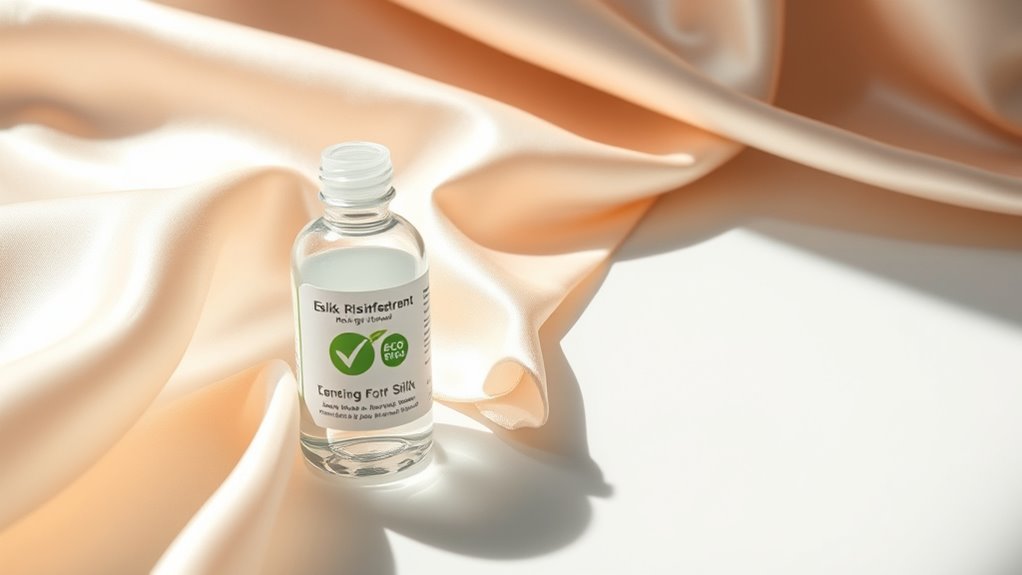
To guarantee a disinfectant is gentle enough for silk fabrics, start by checking the product label for specific mention of suitability for delicate materials. Look for words like “gentle,” “safe for silk,” or “suitable for delicate fabrics.” Avoid products with harsh chemicals such as bleach or high alcohol content, which can damage silk fibers. Check for ingredients like quaternary ammonium compounds or hydrogen peroxide, which are often milder options. Always read the instructions carefully to ascertain proper dilution and application. If in doubt, perform a spot test on a hidden area of the fabric before full use. This step helps confirm that the disinfectant won’t cause discoloration or deterioration, keeping your silk items safe and pristine. Additionally, understanding the types of cookies used on product websites can help you make informed decisions about researching and verifying product safety and efficacy.
Top EPA-Registered Disinfectants Safe for Silk Items
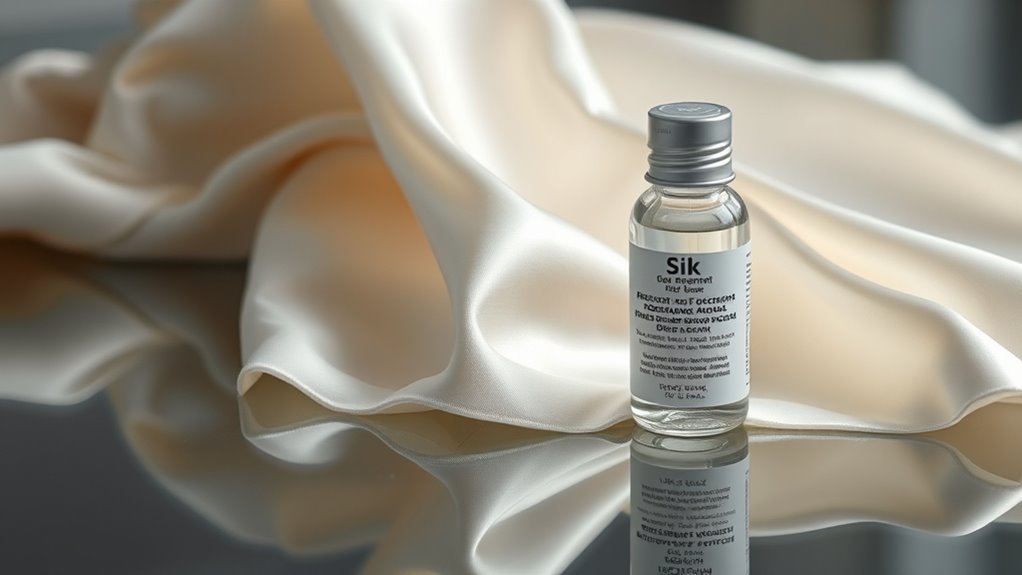
When choosing disinfectants for your silk items, look for those approved for delicate fabrics. These products are effective against common pathogens and safe for storage, ensuring your silk remains undamaged. Using the right EPA-registered disinfectant helps protect your silk without compromising its quality. Additionally, selecting products with HEPA filtration can further improve air quality in storage areas by reducing airborne contaminants.
Approved for Delicate Fabrics
If you need to disinfect silk or other delicate fabrics, it’s important to choose EPA-registered disinfectants specifically labeled as safe for these materials. Look for products that mention “approved for delicate fabrics” or “safe for silk” on their labels. These disinfectants are formulated to eliminate germs without damaging fragile fibers or causing discoloration. Always follow the manufacturer’s instructions carefully, especially regarding dilution and contact time. Using the right disinfectant helps maintain your fabrics’ integrity while ensuring they’re hygienic. Many EPA-registered options designed for delicate items also avoid harsh chemicals that can weaken or stain silk. By selecting products approved for delicate fabrics, you protect your belongings and keep them safe from harmful pathogens. Additionally, choosing disinfectants that are gentle on delicate fabrics ensures your silk remains beautiful and intact after cleaning.
Effective Against Common Pathogens
Many EPA-registered disinfectants labeled as safe for silk are effective against a range of common pathogens, including bacteria, viruses, and fungi. These disinfectants help protect your silk items from illness-causing microbes without damaging delicate fibers. Here’s a quick look at some pathogens they target:
| Pathogen Type | Example | Effectiveness |
|---|---|---|
| Bacteria | Salmonella | Yes |
| Viruses | Influenza | Yes |
| Fungi | Candida | Yes |
You can confidently use these disinfectants to keep your silk clean and safe from germs, knowing they’re both effective and gentle. Always follow label instructions to ensure proper disinfection and preservation of your delicate fabrics. Additionally, understanding skin-friendly formulations can help select products that are safe for sensitive materials.
Safe for Silk Storage
Choosing the right disinfectants for silk storage is essential to protect your delicate items from germs while maintaining their quality. Look for EPA-registered disinfectants labeled as safe for fabrics or textiles. These products are formulated to disinfect without damaging silk’s fibers or causing discoloration. Before applying, test a small hidden area to ensure compatibility. Use disinfectants in a well-ventilated space and avoid soaking silk items. Once cleaned, store your silk in a cool, dry, and breathable container to prevent mold and dust buildup. Keep silk away from direct sunlight and humidity, which can weaken fibers over time. Proper disinfectant use combined with careful storage ensures your silk remains clean, preserved for years, and protected from damage.
Step-by-Step Guide to Disinfecting Silk Without Damage
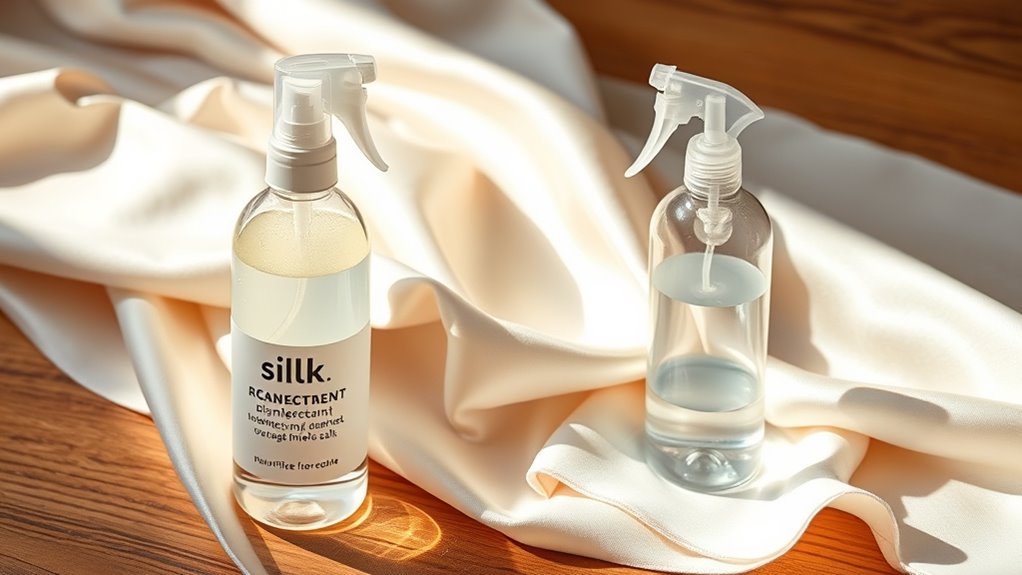
To disinfect silk safely, start by selecting an EPA-registered disinfectant that’s proven to be gentle on delicate fabrics. Next, apply it carefully using proper techniques to avoid damage, ensuring even coverage without oversaturating the material. Finally, let the silk dry completely before handling to prevent any moisture-related issues.
Choose Safe Disinfectants
When disinfecting silk, it’s essential to select products that are both effective against germs and gentle enough to avoid damage. Look for EPA-registered disinfectants labeled safe for delicate fabrics or specifically for silk. Check the product label to ensure it’s non-abrasive, alcohol-free, and free of harsh chemicals like bleach or ammonia. Opt for disinfectants with proven effectiveness against bacteria and viruses, but always verify they’re suitable for silk. Avoid household cleaners or disinfectants not intended for delicate textiles, as they can cause discoloration or deterioration. Reading labels carefully helps you choose solutions that disinfect thoroughly without compromising the fabric’s integrity. Ensuring the disinfectant has a high level of safety for delicate textiles is crucial for maintaining silk’s appearance and longevity. Using the right disinfectant ensures your silk items stay beautiful and protected from harmful germs.
Proper Application Techniques
Ever wondered how to disinfect silk effectively without causing damage? First, verify your hands are clean before handling the fabric. Lightly dampen a soft cloth with the EPA-registered disinfectant, avoiding saturating the silk. Gently wipe the surface, focusing on all areas needing disinfection, but don’t scrub or press hard. Always test a small, hidden section first to check for any adverse reaction. Use minimal liquid to prevent oversaturation, which can harm delicate fibers. After application, avoid rubbing or scrubbing. Instead, gently glide the cloth across the silk, maintaining a light touch. Follow the disinfectant’s instructions for contact time, ensuring the surface stays damp for the recommended duration. Proper technique preserves silk’s integrity while effectively disinfecting. Incorporating proper application techniques can help ensure the safety and longevity of your silk items.
Allow Adequate Drying
Once you’ve finished disinfecting your silk, it’s vital to let it dry thoroughly before handling or storing. Proper drying helps prevent mold, mildew, and lingering moisture that could damage the fabric. Place your silk in a well-ventilated area away from direct sunlight, as UV rays can cause fading. Avoid wringing or squeezing the fabric, which can distort its shape. Instead, gently lay it flat on a clean, dry towel or hang it on a padded hanger. Allow ample time for complete evaporation of any remaining disinfectant. Rushing the drying process can trap moisture, risking damage or mold growth. Patience ensures your silk stays beautiful and intact, maintaining its delicate texture and appearance after disinfection. Additionally, understanding fabric care can help preserve the quality of your silk over time.
Common Mistakes to Avoid When Disinfecting Silk Textiles

Disinfecting silk textiles requires careful attention, as improper techniques can damage delicate fibers or diminish their appearance. One common mistake is using harsh chemicals or excessive disinfectant, which can weaken or discolor silk. Always follow the instructions on EPA-registered disinfectants, ensuring the correct dilution and contact time. Avoid scrubbing or rubbing the fabric vigorously, as this can cause fraying or stretching. Using high heat or direct sunlight during drying can also harm silk fibers; stick to gentle air drying in a shaded area. Additionally, never submerge silk in disinfectant solutions for too long, as prolonged exposure can lead to damage. Being cautious and precise helps preserve the beauty and integrity of your silk textiles while keeping them disinfected.
Alternative Methods for Maintaining Silk Hygiene Safely
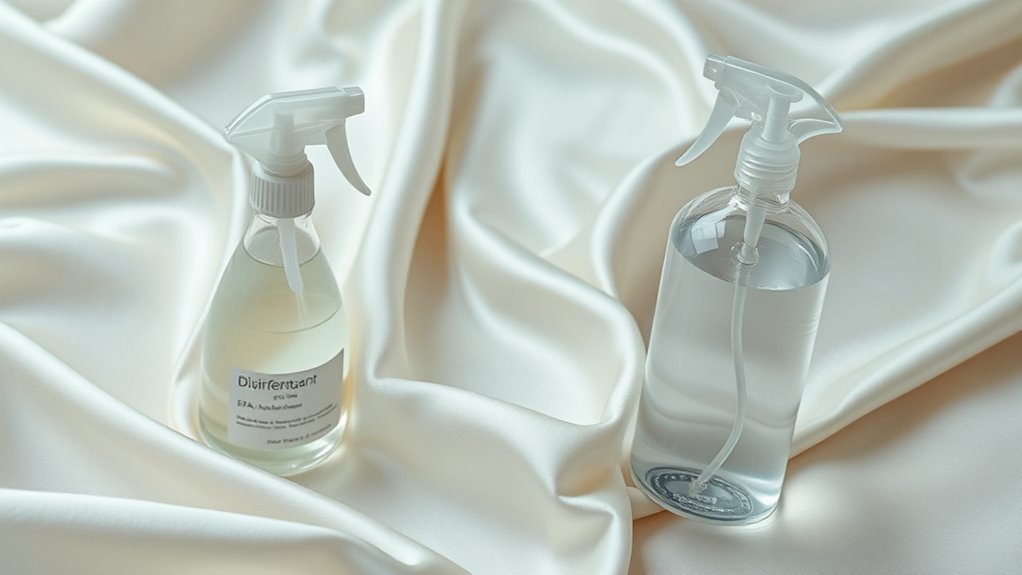
You can keep silk clean using safe, gentle cleaning techniques that don’t require harsh chemicals. Consider options like mild soap and water or natural disinfectants to maintain hygiene without risking damage. These methods help preserve your silk’s beauty while ensuring it stays hygienic.
Safe Disinfection Options for Silk
Maintaining silk hygiene without risking damage requires careful selection of safe disinfection methods. You should opt for options that effectively eliminate germs while preserving silk’s delicate fibers. Lightly spraying silk with a mixture of water and a few drops of gentle, silk-safe disinfectant can work well. You might also consider using a diluted alcohol solution, such as isopropyl alcohol, applied with a soft cloth, but test a small area first. Another safe method is steaming silk using a handheld steamer at a safe distance, which kills bacteria without harsh chemicals. Always ensure the disinfectant used is gentle and specifically safe for silk. Avoid harsh chemicals or bleach, which can weaken or discolor the fabric. These options help maintain hygiene while protecting the integrity of your silk items.
Gentle Cleaning Techniques
When it comes to keeping silk clean without causing damage, gentle cleaning techniques are essential. You should avoid harsh chemicals and abrasive scrubbing, opting instead for soft methods that preserve the fabric’s delicate fibers. Start by gently brushing off surface dirt with a soft cloth or brush. For spot cleaning, use a mild detergent diluted in cold water, and dab gently with a clean cloth—never rub, as this can weaken the silk. If the fabric needs a more thorough clean, hand wash it carefully, avoiding excessive agitation. Always rinse with cold water and lay the silk flat to dry, away from direct sunlight or heat. These gentle techniques help maintain silk’s luster and softness, ensuring it stays beautiful and undamaged over time.
Tips for Preserving the Shine and Texture of Silk During Disinfection
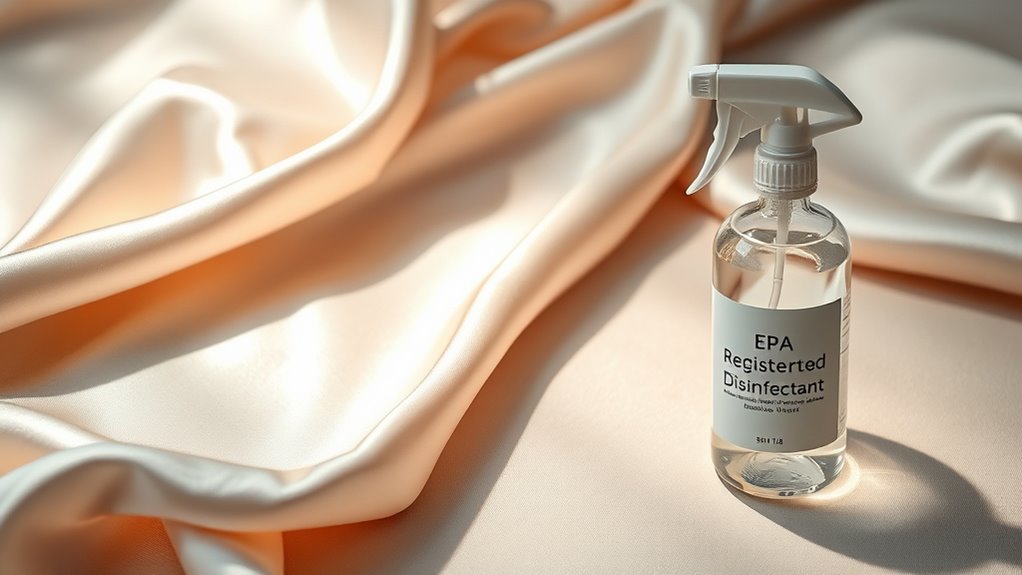
To preserve the shine and texture of silk during disinfection, it’s vital to choose gentle cleaning methods and products specifically designed for delicate fabrics. Always opt for disinfectants labeled safe for silk to prevent damage. When applying disinfectants, test a small, inconspicuous area first to ensure there’s no adverse reaction. Avoid soaking silk items for extended periods, as prolonged exposure can weaken fibers. Use a soft cloth or sponge to gently dab the disinfectant onto the fabric, rather than rubbing it vigorously. After disinfecting, lay the silk flat to dry in a shaded area, avoiding direct sunlight which can cause fading. Store your silk properly in a cool, dry place, and handle it with clean hands to maintain its natural luster and softness over time.
The Role of Ph Levels and Ingredients in Safe Disinfectants for Silk
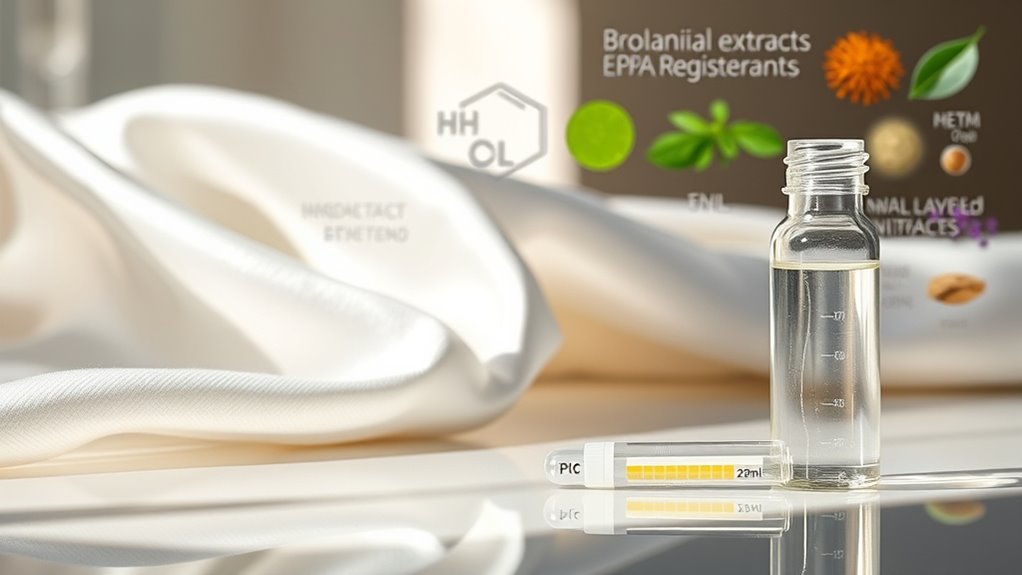
Since silk is a delicate fiber, the pH level and ingredients of disinfectants play a crucial role in guaranteeing safe cleaning. You should look for disinfectants with a neutral or slightly acidic pH, ideally between 5.5 and 7, to prevent damage to the silk’s fibers. Harsh chemicals or high pH disinfectants can weaken or discolor the fabric. Ingredients matter too; avoid those with alcohol, bleach, or strong acids, as they can cause deterioration. Instead, opt for EPA-registered disinfectants specifically formulated for delicate fabrics. These products typically contain milder active ingredients that effectively disinfect without compromising silk’s texture or sheen. Always check labels carefully to ensure compatibility with silk, preventing any unintentional damage during cleaning.
Expert Recommendations for Disinfecting and Caring for Silk Fabrics
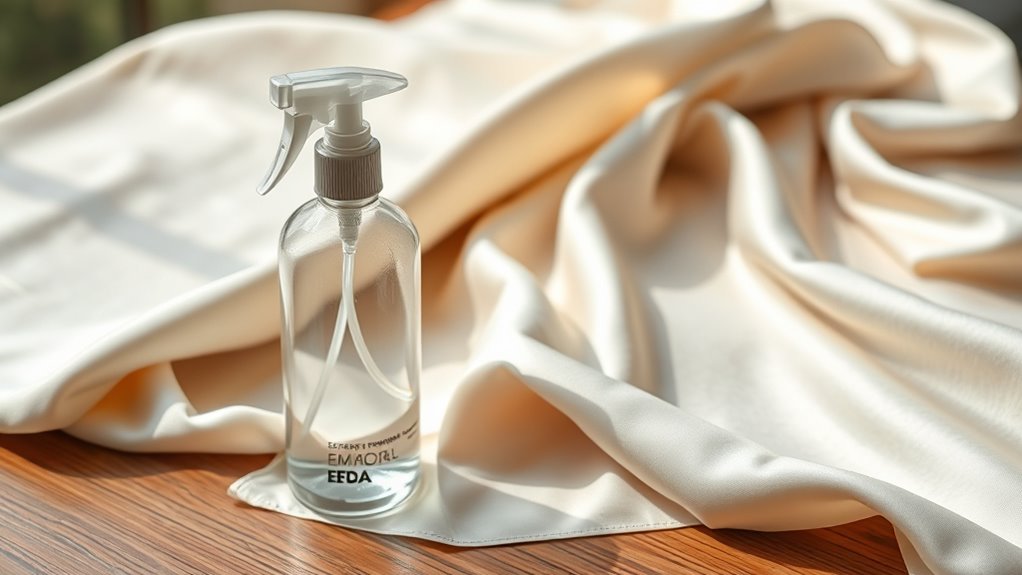
Expert recommendations emphasize that caring for silk fabrics requires gentle, informed cleaning practices to preserve their beauty and longevity. Always test any disinfectant on a small, hidden area first to ensure it doesn’t damage the fabric. Use a soft cloth or sponge dampened with a mixture of mild detergent and water for regular cleaning. For disinfecting, opt for EPA-registered disinfectants labeled safe for silk, and follow the manufacturer’s instructions carefully. Avoid soaking silk or using harsh chemicals, as they can weaken fibers and cause discoloration. After cleaning, air dry silk away from direct sunlight to prevent fading. Store silk in a cool, dry place, preferably in breathable covers. Following these expert tips helps maintain silk’s delicate luster while ensuring it stays hygienic.
Frequently Asked Questions
Can I Use Household Disinfectants on Silk Safely?
You wonder if household disinfectants are safe for silk. It’s best to avoid using standard disinfectants on silk, as they can damage the delicate fibers. Instead, opt for products specifically labeled as safe for silk or gentle solutions like diluted white vinegar. Always test a small, hidden area first and follow the manufacturer’s instructions. This way, you protect your silk items while ensuring they’re properly disinfected.
How Often Should I Disinfect Silk Items?
You might think disinfecting silk is a formidable task, but it’s simpler than you imagine! You should disinfect silk items only when necessary, like after potential exposure to germs or illness. Typically, once every few weeks or during flu season suffices. Use gentle, silk-safe disinfectants, preferably EPA registered, to keep your delicate fabrics fresh without damage. Over-disinfecting can weaken silk, so always prioritize cleanliness but avoid excess.
Are There Natural Disinfectant Options Safe for Silk?
You might wonder if natural disinfectants are safe for silk. Yes, some options like diluted vinegar or alcohol can work, but you must be cautious. Always test a small area first to avoid damage. Keep in mind that natural disinfectants may not be as effective as commercial products, so use them carefully and sparingly. Proper cleaning helps protect your silk items while maintaining their beauty.
Does Disinfecting Affect Silk’S Color or Dye?
Disinfecting silk can affect its color or dye, especially if harsh chemicals or strong disinfectants are used. You might notice fading or discoloration over time. To protect your silk, choose gentle, silk-safe disinfectants and follow the instructions carefully. Always test a small, hidden area first. Properly disinfecting while preserving silk’s vibrant colors requires careful product selection and cautious application.
Can Disinfectants Be Used on Silk With Other Delicate Fabrics?
You can use disinfectants on silk mixed with other delicate fabrics, but you need to be cautious. Always check the disinfectant’s label to verify it’s safe for delicate textiles, and perform a patch test first. Use gentle, diluted solutions and avoid harsh chemicals. Disinfecting delicate fabrics together can be safe if you follow proper guidelines, but always prioritize gentle products to prevent damage or color fading.
Conclusion
So, next time you’re enthusiastic to disinfect your delicate silk, remember that the EPA’s registered disinfectants are your best friends—if you can find one gentle enough. Ironically, the very products designed to kill germs might threaten your silk’s shine and softness. But with a little knowledge and care, you can keep your silk pristine without turning it into a chemical battleground. After all, who knew disinfection could be so complicated?









